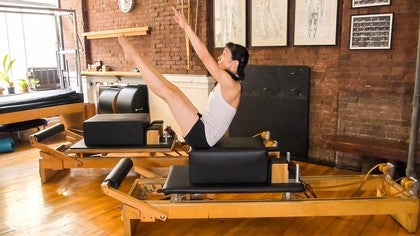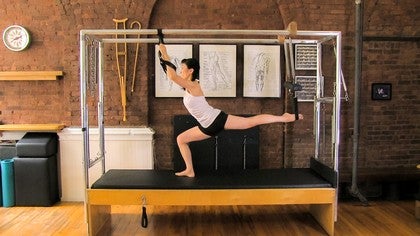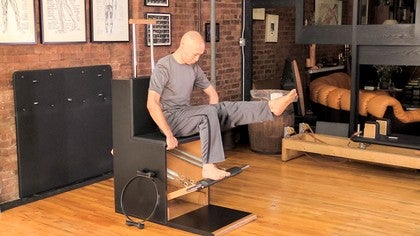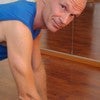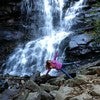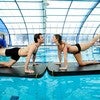Description
About This Video
Transcript
Read Full Transcript
The session begins with the foot work. Corolla used to say that doing your footwork was like taking a brisk walk across the Brooklyn Bridge. So in a sense it was your warm up, but it's so much more than that. So the first position was toes apart, heels together. The second position is toes and heels together, all the while keeping the metatarsal [inaudible] weight bearing on the foot bar and the toes wrapped around so that you are contracting the muscles underneath the metatarsal arch.
The third position is on the heels with the heels and toes together. And even in this position there's activity in the sole of the foot so that the foot work according to Corolla was the beginning of your weight bearing posture when you're vertical flex point, flex point, this is the tendon stretch in which the legs are extended all the way through good and then finally heals wide. The turnout is only from the hip joint and the center of the knee faces the little toe. So these are all directives from Corolla. Now the only thing that we have changed here is that originally the foot bar was higher.
The head rest was up and the head was also supported with a pillow so that the back was flat. Now we are hip width apart for single leg in which we've taken off one spring to make the resistance a little bit lighter. And the spacing hip with the part is actually a little bit wider than the sit bones so that you have to counter stabilize in the torso as you're standing on that one leg.
So let's go directly to single foot tendon stretch, good. And on the single foot tendon stretch, you bring the carriage in. In between extensions, even though we call this footwork, we are working the whole body. So the trunk has to be constantly elongating. And as Kathy grant once said, if Joe wanted you to push out with his feet, he would have put the wheels under the feet. The wheels are back under the upper body, so the upper body has to carry the platform back and you oppose with the lower body, increasing the overall length.
Now we're going to transition directly into coordination. You're going to keep the upper body rounded forward, bend the arms and legs, knees into the chest. Stay up through your upper body, round forward and stay up through your upper body. And exhale, stretch accent together. Draw the knees in. Keep the upper body rounded and just bend the arms and exhale. Good. The abdominals go deep, deeper, deepest. One more time.
Deep, deeper, deepest stay rolled down through the upper body. Extend the legs all the way down on top of the bar. Now you go is going to do assisted jackknife with Yoshi. Inhale, arms down. Exhale, overhead position. Inhale, the legs go up, the spine stays inflection. Exhale you go is giving very mild resistance.
The arms come up and the legs float down. Now we're going to do backstroke. Swimming. The spine is inflection throughout this exercise, so you're deepening the chest, you're keeping your focus forward, and the low back stays firmly into the mat and stay and now the beats, which was an add on that Corolla gave to give you more abdominal work.
It's an absolutely beautiful movement and for some reason Corolla only let the dancers do the Swan. There was some unwritten rule that extension was only for dancers, so of course we have changed very much from those days. That being said, this is difficult coordination involving a lot of strength and to perform it as beautiful as you go and Yoshi takes a of technique. Now we're going to show you stomach control. Stomach control is all abdominals.
No hip flexors. Stomach control has a constant rhythm, which is just like the waves coming in and rolling back out. And as you progress from one version to the next, you're carrying more and more weight back behind you, meaning you have to control from the bottom of your abdominals to keep your spine free. This is also a fabulous exercise to work on your Peloton breathing. The arms stay folded and now we take the spine from the central axis into rotation.
The fingertips are at the base of the neck so that the arms can't pull on the head or neck. So in this exercise we're actually doing flection, rotation and side bending and rest. We're now sidelining on the box and literally lying on the side of the hip, letting the full weight of the body hang from the foot strap. UCO is now going to perform breaststroke, which we did at Corollas with a spot in the back. There were photographs on the wall of Corolla performing breaststroke with both Kathy Bay, Kathy Grant, spotting her in the back and also Robert Fitzgerald.
Now you go is going to do an exercise called Arabesque. This may have been just Carola's exercise for people with extreme ranges of motion so you can see as she comes up to stretch her legs that she's actually balancing on her pelvis and then coming back down, much like double leg kick. So Corolla did stomach massage with a box. Kathy grant told me that Joe never did it this way. Um, this is the way I learned it and it really helped people who had difficulty, number one, opening up their low back. And number two, getting into very deep hip flection.
It's called stomach massage because you literally massage your organs with your abdominals. The movement is initiated by the abdominals and now we're doing a version turned out that was for the dancers only. This is very deep in the hip socket and so I only recommend it if you have this kind of range of motion. Now we remove one spring to go from two legs to one leg. Again, hip with the part so that the body has to counter stabilize.
Relevate flex Relevate and in and once more to Relevate and stay. And now the running good. And in between each stroke in the running, you come up to Relevate with the heels together into a very solid position. Bend back in, rise up in the body. The spinals, the way we did them at Corollas were much like rollovers. Now not everyone could do it this way, dropping the feedback into the well behind you. But if you could, you did, you took time to open the low back and then bring the heels down.
You try to keep the platform absolutely still and meet the changing resistance as you roll up and down. So we do three repetitions starting with the legs together, three repetitions, reversing, starting with the legs apart and as an add on if one wanted to, they could follow this with leg circles in the straps. The knee stretch series Corolla used to describe as the two positions a runner takes at the starting blocks for race. So when the kneeling knee stretch, the knees are all the way down on the ground
Words resound in my ears. Double up, drop the chest to the thighs, rolled down and come high up through the upper body. Hips up, head to the knees, press out, roll down and open through the shoulders.
This is also a spinal flection exercise with side bending. Carolla used to say, turn your head arrogantly over your shoulder. This exercise is excellent for scoliosis. It's an enormous stretch on the concave side of the back. And Corolla used to put her hand on the underneath rib cage and have the client sit their weight down into her hand to encourage more lateral flection and keep the chest very deep and the pelvis rounded under so the shoulder actually can glide up as you come in.
Allowing that underneath side to lengthen as much as possible. Chest expansion was done sitting with the leg straight forward and each movement pulling the arms back only took the head to one side. Returning Center and releasing the arms Corollas rowing back is extremely difficult and very much like boomerang in the mat work. This requires a tremendous amount of strength, good and the arms move back and up toward the ceiling and rest. Now we're moving onto rowing front. Corolla had a rolling mirror that Mr Palladino made for her that was exactly the width of the reformer and when you did rowing, she would bring the mirror right in front of you and tell you literally to trace your fingertips up the frame of the mirror.
Sometimes for people with Scoliosis, she would have them hold the strap on their weaker side, mimicking the movement without a strap on the stronger side, incredibly challenging. And now we take the head to the knees and again the arms trace up the sides of the mirror and round over deepening into the low back. And now we changed the handles so the straps are on top of the arms and the hands become right along the hairline so that as you bend in, the fingertips come to the temples, the arms never go any wider than your shoulders and you're opening the upper arm as if you're bringing your wings back. Now Corolla did this variation with the palms facing downward
It's also important that the knees never straighten all the way in this exercise. So you get maximum range of motion in the pelvis of the more common splits that we performed in the studio. This one was Corollas.
Pilates Legacy Project: Carola Trier Methods
Comments
You need to be a subscriber to post a comment.
Please Log In or Create an Account to start your free trial.
